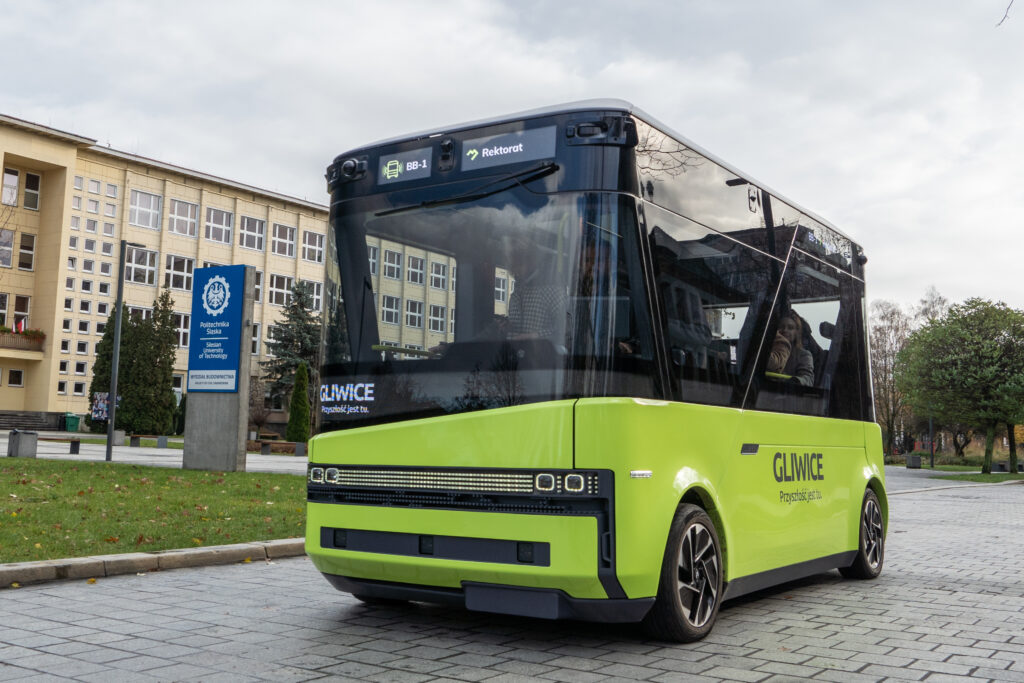
Katowice and Gliwice were the first cities that had the opportunity to test the possibilities of an autonomous minibus in practice
2,799 people transported, over 400 rides between stops, 36 driving days, two Silesian cities and one autonomous vehicle. This is a numerical summary of the first stage of Blees BB-1 minibus testing in public space. The pilot tests carried out in the fourth quarter of 2023 confirmed the readiness of the vehicle for further implementations in more complex conditions.
Katowice and Gliwice were the first cities that had the opportunity to test the possibilities of an autonomous minibus in practice. The tests provided an opportunity to present the technology using advanced sensors, artificial intelligence and 3D object recognition systems to a wider audience. The event was also an opportunity to test an innovative vehicle in urban space and to examine the reactions of residents. The project ran from October 23 to December 19.
While the designated routes were straight sections, the organization of the pilot tests itself resembled riding on intricate serpentines. This is due to complicated regulations that in theory allow autonomous vehicles to be tested on public roads, while imposing prohibitive requirements for their implementation. In Katowice and Gliwice, this was achieved thanks to the favor of the city authorities and the involvement of carriers (PKM Katowice and PKM Gliwice) and the cooperation of services. In the first case, the courses took place in the Valley of the Three Ponds, where temporary traffic organization was introduced on a two-kilometer section of a roller skating routes. For the purposes of the tests, cycling traffic was moved to the side lanes and signs informing about the tests were placed along the route. There were also outlined stops in characteristic places, but at this stage passengers were not transported, but only stopping at certain points was simulated. The next step was a pilot test in Gliwice, scenario of which assumed the implementation of shorter rides, but on a public road, within a strictly defined schedule and transporting people on board. Due to the specificity of the event, each “passenger” had the status of a test participant, whereas rides were possible thanks to the use of the road in a special way. Althoughthe 450-meter section of Akademicka Street where the tests took place is relatively short, in some respects it was a challenge during the tests. First of all, it is a zone in the heart of the campus of the Silesian University of Technology, where there is a lot of pedestrian traffic, and construction works were carried out within the route. It is also an access road for fire engines from the nearby headquarters of the State Fire Service. Despite BB-1, this vehicle has proved the demanding test exemplary, carrying out about 400 autonomous rides and transporting 2,800 tests participants.

Autonomous vehicle for any weather
The autumn weather during the tests provided an excellent opportunity to check the readiness of the vehicle and the functioning of the autonomy system in changing weather conditions. However, rain, snow, low temperatures or high sunshine did not constitute an obstacle to the implementation of the rides. The test scenarios were performed as scheduled and the vehicle was technically available for 97.6% of the test duration. Single downtime was associated with standard maintenance works (including software updates and tire replacement). During the pilot tests, the high efficiency of precise vehicle position location (GNSS, IMU) systems in various environments – such as a park with a large number of trees or a campus built up with tall buildings – was also confirmed. This is an important element that confirms the readiness of the vehicle for further implementations in a very diverse space.

Safety during tests
What is worth emphasizing both in Katowice and Gliwice, there were no situations that would threaten the life or health of traffic participants. Information boards and warning signs were placed on the area where the BB-1 was moving, and at the University of Technology, in addition, volunteers took care of the safety. The local operator, who supervised the tests, also took care of the safety of the ride. In addition, the speed of the ride was adapted to the specifics of the route (<10 km/h in Gliwice and <15 km/h in Katowice). Despite this, there have been individual cases in which traffic participants did not comply with the rules of the event, running to the route to find out what the vehicle will do in such situations (!). However, the autonomy system responded correctly, slowing down or stopping the vehicle, and there were no dangerous events during the rides that required the sudden intervention of a local operator. In individual cases, he gave the autonomy system a command to slow down if he judged that something or someone could disrupt the ride. However, the situations were incidental and resulted from the preventive attitude of the person supervising the ride.
Social dimension of tests
The Blees BB-1 autonomous vehicle tests are an event that should be considered on several levels. On the one hand, it is, of course, a test for the technology being developed and the possibility of its practical use. On the other hand, it is a chance for cities and transport operators to get acquainted with a pioneering solution that will change the face of public transport. However, the impact on public opinion resulting from the introduction of an autonomous minibus on the roads should also be taken into account. This event aroused great interest of both residents and the media. The scale of this phenomenon is reflected in statistics. During the tests, over 500 publications and records appeared in local and national media. Information about BB-1 was published in the news services of the 10 most influential media in Poland and the vehicle was presented in live programs in the largest TV and radio stations. The great popularity of the project resulted in a large number of people interested in a ride, not only from Silesia, but also from all over the country. The record holders, in order to be able to see for themselves how the first Polish autonomous minibus rides, came especially from Bydgoszcz and Białystok.
One of the assumptions of the pilot tests was also to examine the reactions of passers-by and test participants in order to determine attitudes towards an autonomous bus, learn its assessment and verify the readability of the passenger information system (SIP). The research in this area is organized by scientists from the Silesian University of Technology and the University of Silesia, who are developing 300 questionnaires collected during the tests (the results will soon be published on our blog).
Autonomy is the future of public transport
Autumn tests confirmed the technological and organizational readiness of the Blees team for further development of the project of an autonomous Polish minibus. Taking into account the great interest in the vehicle, positive opinions and successfully completed first pilot tests, we are convinced that in the next few years autonomous vehicles will complement the fleet of carriers in Poland and Europe. In this way, they will help to reduce the operating costs of public transport, solve
the problem of the shortage of professional drivers and improve the implementation of connections on routes where it is currently inefficient. Autonomous vehicles will also make rides safer and reduce the negative impact of transport on the environment. Each subsequent implementation brings us closer to achieving these goals, which is why the schedule for 2024 includes pilot tests that will again be carried out with the participation of external tests participants. We will inform about the details in our social media channels.
The success of the tests also sends a clear signal to legislators that the growth of autonomous transport is gaining momentum. We hope that the results of our work will give impetus to positive legislative changes that will help to introduce the first autonomous bus with type-approval to the market in Europe. As confirmed by the pilot tests, there is a chance that it will be a Polish project.


